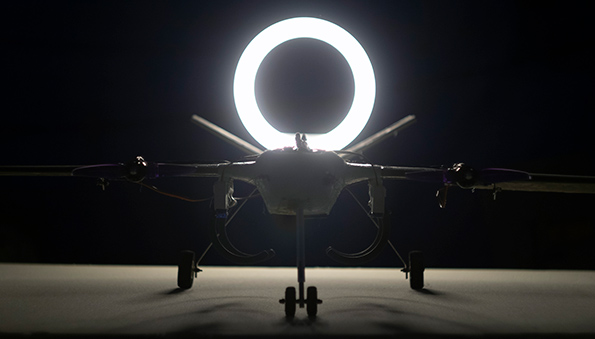Two world podiums in 2023 and 2024
Aero Design UPV, made up of 50 students with a passion for aviation, travels to the United States in search of another aerospace dream
[ 01/04/2025 ]
This weekend, at Apollo XI Field in Van Nuys (California, USA), Aero Design UPV, the UPV Design Factory team from the Universitat Politècnica de València (UPV) made up of fifty students with a passion for aviation, model aircraft and aerospace engineering, will be looking for their own American dream: after two podium finishes in previous years (second and third place in 2023 and 2024, respectively), to be crowned world champions in the 2025 SAE Aero Design West, the leading international university competition in the sector.
‘Our goal is to complete the entire mission... and to try to be, once again, among the best in the world,’ says Guillermo Ballesteros, a student on the UPV Bachelor's Degree in Aerospace Engineering and team leader of Aero Design UPV.
On Wednesday, to Los Angeles
Together with 9 of his colleagues (the coordinators of the team's 5 departments - Aerodynamics, Structures, Manufacturing, Electronics and Marketing - and another 5 members chosen for their ‘merits accumulated throughout this year of work’), Guillermo will fly to Los Angeles this Wednesday, 2 April, for the final phase of a competition that will take place from Friday 4 to Sunday 6 in Van Nuys.
‘The competition lasts three days,’ says Carla Conejero, the team's aerodynamics coordinator. ’The first day is an inspection, in which the judges check that all the measurements we have sent in the plans and the report are correct and that the aircraft is safe to fly. Once the inspection has been passed, from the second day onwards, we have the airfield open to carry out missions, which consist of taking off in conventional flight, detecting the landing zone, going into vertical flight, depositing the load, picking up another load, returning to conventional flight and landing. We have 15 flights, and only the 3 best teams score,' explains the 4th year student of the Bachelor's Degree in Aerospace Engineering.
Orion, facing the great challenge
The great challenge of continuing on the path of previous successes has, this year, an added extra difficulty: the important regulatory change that limits the empty weight of the aircraft to just 1.53 kilograms when Stingray (Aero Design UPV's aircraft for the 2023 competition) weighed 17 kg empty, and White Fury (the 2024 one), 10 kg.
'The main problems arising from the regulatory change,' adds Carla, 'have been how we approach the weight limitation, which has forced us to research materials, aircraft manufacturing, and the transition from conventional to vertical flight.'
The answer to the great challenge is Orion, a small aircraft weighing just 1.3 kg empty and capable of meeting another of the great demands of SEA Aero Design West: 100% autonomous flight.
‘We are very proud of the work we have done,’ says Guillermo, ’which would not have been possible without the support of UPV Design Factory, the UPV itself and all our other sponsors: the Regional Government of Valencia, the School of Aerospace Engineering and Industrial Design (ETSIADI-UPV), the School of Telecommunications Engineering (ETSIT-UPV), the Clean, Mobility & Thermofluids (CMT-UPV), Siemens, HP, Matlab, Einhell, Ansys, nTopology, Onklub, DM Decoraciones y Manualidades, Symula, Tiendatec and Fibrojet. We are extraordinarily grateful to all of them.
SAE Aero Design West
SAE Aero Design is a competition devised by SAE International, an organisation focused on the mobility of professionals in aerospace engineering, automotive engineering and all commercial industries specialising in vehicle construction.
Founded as the Society of Automotive Engineers in 1905, SAE International aims to develop standards for all types of vehicles. In this context, since 2017, it has promoted two aerospace engineering competitions for university teams, SAE Aero Design East and SAE Aero Design West, an ideal breeding ground for companies looking to attract young talent from the sector.
UPV Design Factory
In this line, the success of Aero Design UPV in particular and, in general, of the UPV Design Factory teams, the support platform created by the UPV for the realisation of extracurricular activities and the participation in national and international events of its most active students, stands out.
'The advantage of being in a UPV Design Factory team,' concludes Carla, 'is that it gives you the chance to work on things you are studying in your degree in a much more practical way while meeting people and companies in the sector and getting an idea of what your future job will be like.'
The talent of the UPV is on display. Now, Guillermo, Carla and the rest of their colleagues will try to continue making it shine this weekend in California before the rest of the world. Good luck, great team!
Carlos Ayats Pérez / UPV Communication Area
Outstanding news
 Study a degree at the best technological university in Spain
Study a degree at the best technological university in Spain
The Universitat Politècnica de València is ranked number 1 among Spanish technology universities, according to the Shanghai ranking
 National Research Award
National Research Award
Ramón Martínez Máñez has received the "Juan de la Cierva" National Research Award in the area of Knowledge Transfer
 The UPV and Beihang University strengthen their academic and scientific alliance
The UPV and Beihang University strengthen their academic and scientific alliance
The two universities have signed a new collaboration agreement as part of the celebration of "UPV Day" in China
 Study in English
Study in English
The UPV offers eight degrees, 16 master's and 650 courses in English for the 2025-26 academic year
 THE Impact Ranking
THE Impact Ranking
The UPV, the Spanish university with the greatest social and economic impact in the world


